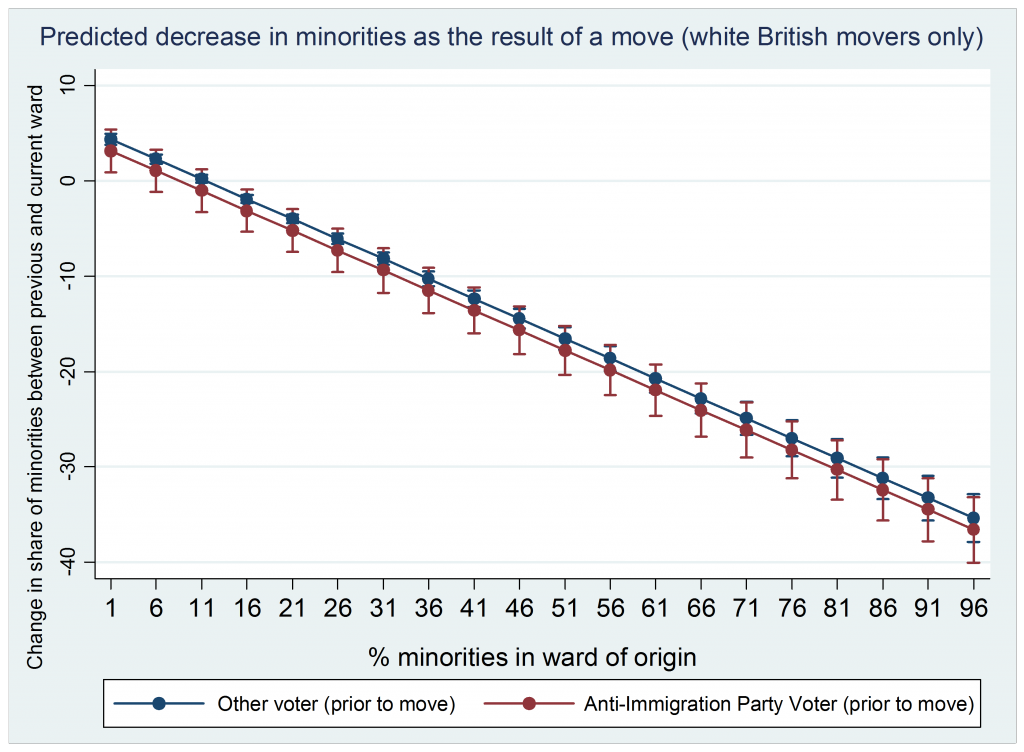 New research by Eric Kaufmann finds that local diversity does lead to more tolerant white attitudes and this is not the result of ‘white flight’. The results suggest that, as more locales become diverse, there will be more interethnic contact and more positive white attitudes to outgroups.
New research by Eric Kaufmann finds that local diversity does lead to more tolerant white attitudes and this is not the result of ‘white flight’. The results suggest that, as more locales become diverse, there will be more interethnic contact and more positive white attitudes to outgroups.
Does living in a diverse area make whites more tolerant of immigration and minorities, or does it cause them to feel threatened and insecure? If whites in diverse places are more tolerant is this because the intolerant whites have left? These questions have important implications in an age of migration. Whether western societies veer to the populist right or towards cosmopolitanism hangs in large part on the answers. This discussion also bears on whether ethnic groups can rub along in divided societies such as Northern Ireland and Syria, or in segregated spots like Chicago and Cape Town.
Gareth Harris and I grapple with these issues in our recently published open access article in Comparative Political Studies. In England and Wales, we find that White British people in wards with more minorities and immigrants are more open to immigration. In wards that are almost entirely white, 90 per cent of White British people want immigration to be reduced; but where visible minorities make up half or more of the population, this drops to about 70 per cent. Half the effect arises because whites in diverse wards tend to be young single urban renters, all relatively tolerant segments. The other half of the explanation, however, seems to involve ‘contact’: mixing with minorities or becoming accustomed to their presence.
We looked at the existing literature and found 24 studies looking at attitudes in units with less than 10,000 people, such as British wards or American census tracts. In these studies, three quarters discovered positive contact effects in which whites living with larger shares of minorities and immigrants displayed more positive attitudes toward outgroups than whites in whiter areas.
Yet there is another, less sunny, side to the story. When we looked at larger geographies above 100,000 population, such as the English Local Authority (LA) or American county, the relationship reversed itself. Of 44 papers we sampled, 84 per cent found a threat effect in which whites living in more diverse places expressed more hostile attitudes to minorities and immigrants.
We confirmed this pattern for immigration opinion in England and Wales using the 2009-2011 Citizenship Surveys. Controlling for numerous properties of individuals, such as education, and of areas, such as deprivation score, white British people in diverse wards (population averaging 7,500) are ten points more accepting of immigration than those in the whitest wards. By contrast, whites in diverse Local Authorities (population around 100,000) are around five points more likely than whites in homogenous LAs to call for restriction.
Moreover, whites living in homogeneous wards nested within diverse LAs express the greatest opposition to current levels of immigration. This echoes what Rydgren and Ruth, in relation to Sweden, dub the ‘halo effect’, whereby anti-immigration party support is strongest in white working-class areas adjacent to diversity. The same pattern shows up in support for the far right in Britain. In the 1970s, East London was a hotbed of National Front activity. By the 2008, East London had become diverse and, as figure 1 shows, the red ‘halo’ of far right support shifted further out.
Figure 1: BNP vote share in 2008 Greater London Authority election
Source: Kaufmann, E. and G. Harris, Changing Places: mapping the white British response to ethnic change (London: Demos, 2014), p. 73
One explanation for the above pattern comes from contact theory: whites who live in diverse Local Authorities or counties lack opportunities to mix with minorities but are close enough to be worried. A policy solution would be to encourage more opportunities for positive inter-group contacts, such as educational, religious or sporting exchanges. A useful analogy is with attitudes to nuclear power plants. Those who live far enough away not to worry, or close enough to understand the actual risks, are less fearful than those in the middle.
But contact theory is not the only explanation for the bifurcated pattern we see. ‘White flight’, the self-selection of white British people who dislike diversity out of multicultural wards, could account for white tolerance in diverse areas and relative intolerance in adjacent districts. This question has not been properly addressed because most previous research has run into data limitations. Longitudinal surveys – those which sample the same people every year – are needed to examine movers. In Europe or the US these do not ask subjective questions so it is impossible to track the opinions of movers. Work with the US Panel Study of Income Dynamics, for example, tells us that whites move to whiter areas than minorities. There is, however, no way of discerning whether anti-immigration whites are overrepresented among those moving to whiter areas.
Luckily, the British Household Panel Survey (BHPS), now Understanding Society (UKHLS), allows us to explore the political leanings of thousands of individuals over two decades. The surveys don’t directly ask about immigration, but we know from other sources such as the British Social Attitudes Survey and British Election Study that certain kinds of voters are relatively pro-immigration while others are very much against. For instance, university-educated left-wing voters (Green, Labour, Lib Dem) tend to be pro-immigration. Conservative voters without degrees, or supporters of populist right parties such as UKIP or the BNP, tend to favour lower levels. We augment the longitudinal work with a specially commissioned YouGov survey which asks people about immigration, party support and whether they moved toward or away from diversity during the past decade.
The results are striking. Essentially, while white British people select whiter areas to move to than minorities, whites who favour and oppose immigration move to similar places. In figure 2, we see that, controlling for a wide range of individual and ward characteristics, such as education or deprivation, whites who originate in diverse wards tend to move to much whiter ones. Yet there is barely a paper clip’s difference between whites who vote for anti-immigration parties (mainly BNP and UKIP) and other whites.
Figure 2: Predicted decrease in minorities as the result of a move (white British only)
Source: Understanding Society, waves 1-3 (2009-12)
Among White British respondents in the BHPS, there is a significant difference between university-educated left-wing (i.e. pro-immigration) voters and others, but the difference is small – only two percentage points. And this only concerns white ‘avoidance’, that is, selective inflow. On the other hand, there is no difference between pro-immigration whites and anti-immigration whites in their propensity to leave a diverse area, i.e. ‘white flight’. If the population of a ward is like water in a tub, we could say that in diverse areas, the water is relatively liberal on immigration. The water entering the tub is 2 points more liberal than average while the water exiting reflects the national average. Even if the entire content of the tub changed completely to match the inflow, the most that self-selection can explain is 2 of the 10-point difference in immigration attitudes between the least and most diverse wards in England and Wales. This almost certainly overstates the effect. The ONS Longitudinal Study shows that there is a significant share of long-term white residents in diverse British wards. We know from our YouGov survey that these ‘stayers’ are more likely even than whites who leave to favour lower levels of immigration.
The bottom line: local diversity does lead to more tolerant white attitudes and this is not the result of white flight. As more locales become diverse, this should lead to interethnic contact and more positive white attitudes to outgroups. Yet at the same time, the ‘halo’ of threat will push out to new areas, awakening threat perceptions. Since more whites live in diverse LAs than in diverse wards, it is difficult to know where the balance will lie. This means policies such as refugee dispersal which reduce minority segregation may not produce more positive white attitudes to immigration. Indeed as we note elsewhere, rapid changes often produce the opposite effect, so policies designed to reduce segregation are better justified on other grounds.
Note: This article gives the views of the author, and not the position of the British Politics and Policy blog, nor of the London School of Economics. Please read our comments policy before posting.
 Eric Kaufmann is Professor of Politics at Birkbeck College, University of London. His latest publication is a Demos report, freely available, entitled Changing Places: the White British response to ethnic change.
Eric Kaufmann is Professor of Politics at Birkbeck College, University of London. His latest publication is a Demos report, freely available, entitled Changing Places: the White British response to ethnic change.










So how does contact theory explain the explosion in the gentrification of key “minority” areas across London, the increasing displacements of poor, non British whites in places like Brixton, Stoke Newington and so on? Surely it is unhelpful even misleading to conclude that British whites are staying in places like London due to increased tolerance of non-whites, when non whites are actually being displaced and pushed out of their localities?
Dear Sir,
Sorry if I ask a stupid question, but you state that research show ‘stayers’, a a significant share of long-term white residents, are more likely even than whites who leave to favour lower levels of immigration. However, you also state that white flight is not disproportionately anti immigration. That would suggest, if I understand it all, that *originally* the ‘stayers’ were similarly in favour of lower level immigration as the white flight.Otherwise the white flight would have to be in favour of higher level of migration, or less opposing to migration, to mitigate for the skewed vision of the left behinds.
This would however mean that for the ‘stayer’ the opposite is true: Contact made them more inclined to favour lower migration. It would also mean that it was the non-stayers, i.e. the newly settling whites, that are massively in favour of more migration.
What are your thought on this?
For Iftikhar Ahmad:
Ethnic minority groups in the UK tend to be ethnocentric and slow to adopt British values and traditions. In this respect they are not any better than native Brits as far as bigotry is concerned. The difference is only that immigrant communities are relatively new and not established, therefore underrepresented in big companies. This is the reason why some employers who are native Brits might prefer applicants who are native Brits. Obviously it is not just racism, it has something to do with business related factors. There are cultural differences between native British population and recent immigrants which might influence many aspects of work. Religious practices are among them. Of course there are immigrants and people of immigrant background who have integrated but they are not the majority.
The only way for immigrants to integrate is to adopt British traditions and mentality. Another problem is that the British population has not been asked by the government whether or not they want mass immigration. It was forced onto them, hence the reaction.
A government sting operation targeting hundreds of employers across Britain has uncovered widespread racial discrimination against workers with African and Asian names.
Researchers sent nearly 3,000 job applications under false identities in an attempt to discover if employers were discriminating against job seekers with foreign names. Using names recognisably from three different communities – Nazia Mahmood, Mariam Namagembe and Alison Taylor – false identities were created with similar experience and qualifications. Every false applicant had British education and work histories.
They found that an applicant who appeared to be white would send nine applications before receiving a positive response of either an invitation to an interview or an encouraging telephone call. Minority candidates with the same qualifications and experience had to send 16 applications before receiving a similar response.
In an ideal world, no one would be rejected on the basis of ethnicity. It should not be a factor. The evidence shows that it is. If you want your “colour blind” society, then you have to take active measures to work against this bias until such point as its gone.
IA
http://www.londonschoolofislamics.org.uk
Adam,
Some great points and I’m sorry for the delay in responding. Changing the metric from white to White British share does not affect the results so i don’t think that holds the key to the patterns we see.
However, there is nothing in what I find that contradicts your point that most choose to live in areas with larger numbers of people from their ethnic group, regardless of ideology. I think that is what is going on. But what I find surprising is that whites who vote UKIP/BNP, and those who are, say university-educated Labour voters, are equally likely to choose whiter areas to move to.
This suggests that those who are ideologically pro- and anti-diversity move to ethnically pretty similar places, which casts doubt on the strong version of the white flight hypothesis – that whites who dislike diversity most leave while tolerant whites remain, so diverse areas have more tolerant whites.
This doesn’t mean, however, that whites are not sorting into white areas. They may still be doing so – but the driver in this case is subconscious: beneath the ideological radar of even committed pro- or anti-immigration folk.
I’m not sure I agree. First of all, there is a very straightforward way to measure “white flight” – that is look at the 2011 census ward-by-ward and compare it with the 2001 census. If, as you have, you look at London wards, the proportions of white *BRITISH* residents, in particular in central London but also in the outer boroughs, has dropped vastly. They have been replaced, largely, with white *EUROPEAN* residents – who by definition you might expect to be more favourable to immigration.
Now, if you’re just looking at “white”, then because white Europeans are replacing white Brits, the numbers may not have changed. But if you look at in terms of nationality, the differences are stark. around 3,000 white Britons have left Roehampton ward in Wandsworth (I use this because it’s my ward) in 10 years; again, almost entirely replaced by white Europeans.
Secondly, I respectfully suggest you’re placing too much divide on “anti-immigration” vs “pro-immigration”. I’m not attempting to suggest these two camps are insignificant, but I think behaviour is governed by much simpler herd instinct than those labels suggest. It’s also very little to do with racism (support for the BNP).
Simply put: people generally like living alongside people like themselves. It’s why Southall and Harrow for example have become magnets for Hindus and Sikhs; Brixton, Peckham and Tottenham for African/Caribbean communities and much of the rest of the east of London for muslim communities. You presumably won’t make the case that these communities are “anti-immigration” or racist because they choose to congregate together; and it is by and large the same for white communities.
My point being: a person may be pro managed immigration (or, far more likely, not even have a consciousness about the issue) and still prefer to live in a community that mirrors themselves.
I approach these issues from a political viewpoint: the reason London is becoming a much more Labour-voting city than it has been (and increasingly at odds with the rest of the country) is because of a rapid increase in the non British white population – and that is most easily, and accurately, explained by white [British] flight.